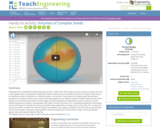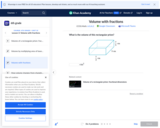
Watch this tutorial to learn about the formula for the volume of a cylinder which is the same as the formula for the area of a circle. [5:33]
- Subject:
- Mathematics
- Material Type:
- Audio/Video
- Provider:
- Virtual Nerd
- Date Added:
- 10/01/2022

Watch this tutorial to learn about the formula for the volume of a cylinder which is the same as the formula for the area of a circle. [5:33]

In this tutorial, learn how to use a cylinder with the same dimensions to find the formula for the volume of a sphere. [4:56]

Students learn the value of writing and art in science and engineering. They acquire vocabulary that is appropriate for explaining visual art and learn about visual design principles (contrast, alignment, repetition and proximity) and elements (lines, color, texture, shape, size, value and space) that are helpful when making visual aids. A PowerPoint(TM) presentation heightens students' awareness of the connection between art and engineering in order to improve the presentation of results, findings, concepts, information and prototype designs. Students also learn about the science and engineering research funding process that relies on effective proposal presentations, as well as some thermal conductivity / heat flow basics including the real-world example of a heat sink which prepares them for the associated activity in which they focus on creating diagrams to communicate their own collected experimental data.

This short video and interactive assessment activity is designed to teach fifth graders about visual objects: comparing length.

This short video and interactive assessment activity is designed to teach second graders an overview of capacity (metric units).

Learn how unit cubes can be used to model the solution for the volume of a 3D figure This video focuses on calculating the volume of a rectangular prism using the equation, length x width x height. This video was submitted through the Innovation Math Challenge, a contest open to professional and nonprofessional producers.

This video gives a clear demonstration of how to figure the volume of rectangular prisms, and of nonoverlapping rectangular prisms. The video is accompanied by an activity and a student handout.

Demonstrates how to calculate the volumes of a triangular prism and a cube. [3:56]
Khan Academy learning modules include a Community space where users can ask questions and seek help from community members. Educators should consult with their Technology administrators to determine the use of Khan Academy learning modules in their classroom. Please review materials from external sites before sharing with students.

Learn to use formulas and unit cubes to model the formula for volume of 3D figures composed of quadrilaterals in this video from KCPT.

A video that shows you how to calculate the volume of a rectangular prism. [4:14]
Khan Academy learning modules include a Community space where users can ask questions and seek help from community members. Educators should consult with their Technology administrators to determine the use of Khan Academy learning modules in their classroom. Please review materials from external sites before sharing with students.

Challenged with a hypothetical engineering work situation in which they need to figure out the volume and surface area of a nuclear power plant’s cooling tower (a hyperbolic shape), students learn to calculate the volume of complex solids that can be classified as solids of revolution or solids with known cross sections. These objects of complex shape defy standard procedures to compute volumes. Even calculus techniques depend on the ability to perform multiple measurements of the objects or find functional descriptions of their edges. During both guided and independent practice, students use (free GeoGebra) geometry software, a photograph of the object, a known dimension of it, a spreadsheet application and integral calculus techniques to calculate the volume of complex shape solids within a margin of error of less than 5%—an approach that can be used to compute the volumes of big or small objects. This activity is suitable for the end of the second semester of AP Calculus classes, serving as a major grade for the last six-week period, with students’ project results presentation grades used as the second semester final test.

Video lesson shows how to find the volume of an irregular 3D figure by breaking the figure into 2 rectangular prisms and finding the volume of each part. [3:48]
Khan Academy learning modules include a Community space where users can ask questions and seek help from community members. Educators should consult with their Technology administrators to determine the use of Khan Academy learning modules in their classroom. Please review materials from external sites before sharing with students.

This video demonstrates a technique for finding the volume of a rectangular prism by dividing it up into fractional cubes. [4:17]
Khan Academy learning modules include a Community space where users can ask questions and seek help from community members. Educators should consult with their Technology administrators to determine the use of Khan Academy learning modules in their classroom. Please review materials from external sites before sharing with students.

Practice finding the volume of rectangular prisms that have fractional side lengths. Students receive immediate feedback and have the opportunity to try questions repeatedly, watch a video or receive hints.
Khan Academy learning modules include a Community space where users can ask questions and seek help from community members. Educators should consult with their Technology administrators to determine the use of Khan Academy learning modules in their classroom. Please review materials from external sites before sharing with students.

This video/animation defines matter, mass, and volume using water as an example. The size, electrical charge and location of the subatomic particles of matter are described. Different types of atoms are called elements and organized in the periodic table. What happens to the properties of atoms when they exist alone or together? [1:16]

Exploring our world is fun! Abby Brown, KIDS Clubhouse Adventures co-host, loves to help kids have fun while learning! In this segment, Abby teaches all about music, including instruments, voice, pitch, tempo, and volume. [2:38]

In this video and worksheets, learners apply mathematical reasoning, critical thinking, and problem-solving techniques to work-related problems.